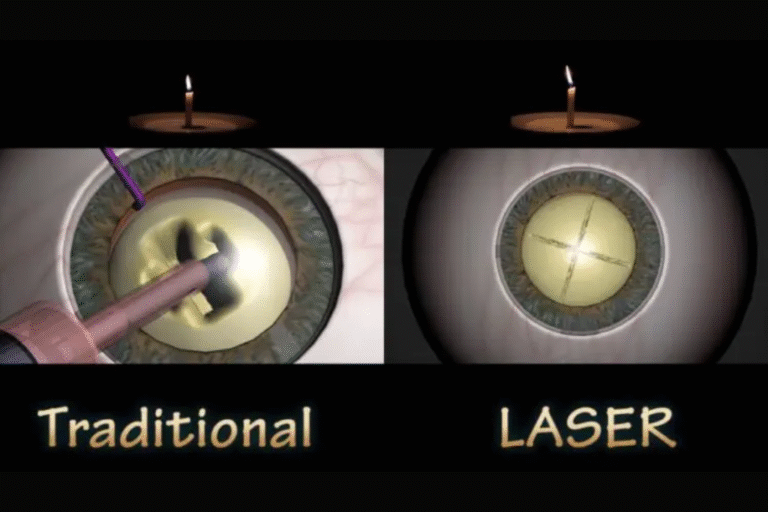Laser vs Traditional cataract surgery: Which is better?

Cataracts are one of the leading causes of vision impairment worldwide, particularly among older adults. Thankfully, cataract surgery is a safe and effective solution to restore clear vision. With advancements in technology, patients now have the option to choose between traditional and laser-assisted cataract surgery. But which one is better? In this blog, we’ll explore both techniques to help you make an informed decision.
Table of Contents
ToggleUnderstanding cataract surgery
Cataract surgery involves removing the clouded natural lens of the eye and replacing it with a clear artificial lens, known as an intraocular lens (IOL). Over the years, this procedure has evolved, and now, patients can choose between:
- Traditional (Manual) Cataract Surgery.
- Laser-Assisted Cataract Surgery.
Let’s explore how these two methods differ and what benefits they offer.
Traditional cataract surgery
What it involves:
Traditional cataract surgery, also known as phacoemulsification, uses handheld instruments to make incisions and break up the cloudy lens using ultrasound energy.
Key steps:
- Surgeon creates a small incision manually.
- Ultrasound probe breaks the cloudy lens into small fragments.
- Fragments are suctioned out.
A new artificial lens is implanted.
Benefits:
- Time-tested and highly successful.
- Short recovery time.
- Widely available and cost-effective.
Limitations:
- Manual precision may vary slightly.
- Higher dependence on the surgeon’s skill.
- Slightly more risk of minor complications compared to laser.
Laser-Assisted cataract surgery
What it involves:
This advanced procedure uses femtosecond laser technology to automate critical steps such as corneal incisions, capsulotomy (opening the lens capsule), and lens fragmentation.
Key steps:
- Laser creates highly precise corneal incisions.
- Laser softens and segments the cataract.
- Remaining procedure is completed similarly to traditional surgery.
Benefits:
- Enhanced accuracy and consistency.
- Better precision in lens positioning.
- Reduced ultrasound energy needed, leading to faster healing.
Ideal for patients with astigmatism. (can be corrected during surgery)
Limitations:
- Slightly higher cost.
- Not necessary for every patient.
- Availability may be limited in some locations.
Key differences at a glance
Feature | Traditional Surgery | Laser-Assisted Surgery |
Incision | Manual | Laser-guided |
Accuracy | Surgeon-dependent | High precision |
Ultrasound use | Moderate to high | Reduced |
Healing time | Fast | Often faster |
Astigmatism correction | Manual methods | Laser can correct |
Cost | Lower | Slightly higher |
Which one should you choose?
At Krisha Eye Hospital, we believe that the best cataract surgery is the one tailored to your specific eye condition and lifestyle needs. Here’s how we help you decide:
- Medical evaluation: We assess the type and severity of your cataract, corneal health, and any coexisting conditions.
- Lifestyle assessment: We consider your visual goals—whether you prioritize glasses-free vision or quicker recovery.
- Affordability & Access: We discuss the costs and insurance coverage for both options.
Our expert opinion
For many patients, traditional cataract surgery remains a highly effective option. However, laser-assisted surgery offers advanced precision and is ideal for complex cases or those seeking premium vision correction outcomes. At Krisha Eye Hospital, our experienced eye specialist doctors in Ahmedabad are trained in both methods and use cutting-edge technology to ensure optimal results for every patient.
Conclusion
Both traditional and laser cataract surgeries are safe, effective, and deliver excellent visual outcomes. The right choice depends on your eye condition, lifestyle needs, and budget. Our experts at Krisha Eye Hospital in Ahmedabad can guide you toward the most suitable option through a personalized consultation.
Book your appointment with our cataract specialists at Krisha Eye Hospital and experience advanced eye care with confidence.
Author bio
Dr. Dhwani Maheshwari, an esteemed ophthalmologist with over 10 years of experience, leads Krisha Eye hospital in Ahmedabad with a commitment to advanced, patient-centered eye care. Specializing in cataract and refractive surgery, Dr. Maheshwari has performed more than a thousand successful surgeries. Her expertise lies in phacoemulsification, a technique recognized for its precision in cataract treatment.
Dr. Maheshwari’s educational journey includes an MBBS from Smt. NHL MMC, a DOMS from M & J Institute of Ophthalmology, and a DNB in Ophthalmology from Mahatme Eye Bank Eye Hospital, Nagpur. She also completed a fellowship in phacoemulsification at Porecha Blindness Trust Hospital, further enhancing her surgical skills. In addition to her work at Krisha Eye Hospital, Dr. Maheshwari serves as a consultant ophthalmologist at Northstar Diagnostic Centre.
Under her leadership, Krisha Eye Hospital aims to bring all superspecialties under one roof, offering comprehensive eye care solutions for all vision needs.
FAQs
The actual surgery takes about 10–20 minutes per eye, although you may spend a couple of hours at the hospital for pre- and post-operative care.
Usually, cataract surgery is performed on one eye at a time. The second eye is treated after the first has healed, often within 1–2 weeks.
It depends on the type of intraocular lens (IOL) you choose. Some lenses can reduce or eliminate your need for glasses, especially for distance vision.
Most patients can resume light activities like watching TV or reading within a day. However, driving, heavy lifting, and swimming should be avoided for at least a week or as advised by your doctor.
Generally, there are no strict dietary restrictions. However, your doctor may advise fasting for a few hours before surgery and a healthy, balanced diet during recovery.
Symptoms like increased pain, sudden vision loss, light flashes, or severe redness should be reported to your doctor immediately, as they may indicate complications.
The cataract itself does not return. However, some patients may develop a “secondary cataract” (posterior capsule opacification), which can be treated with a quick laser procedure called YAG capsulotomy.
